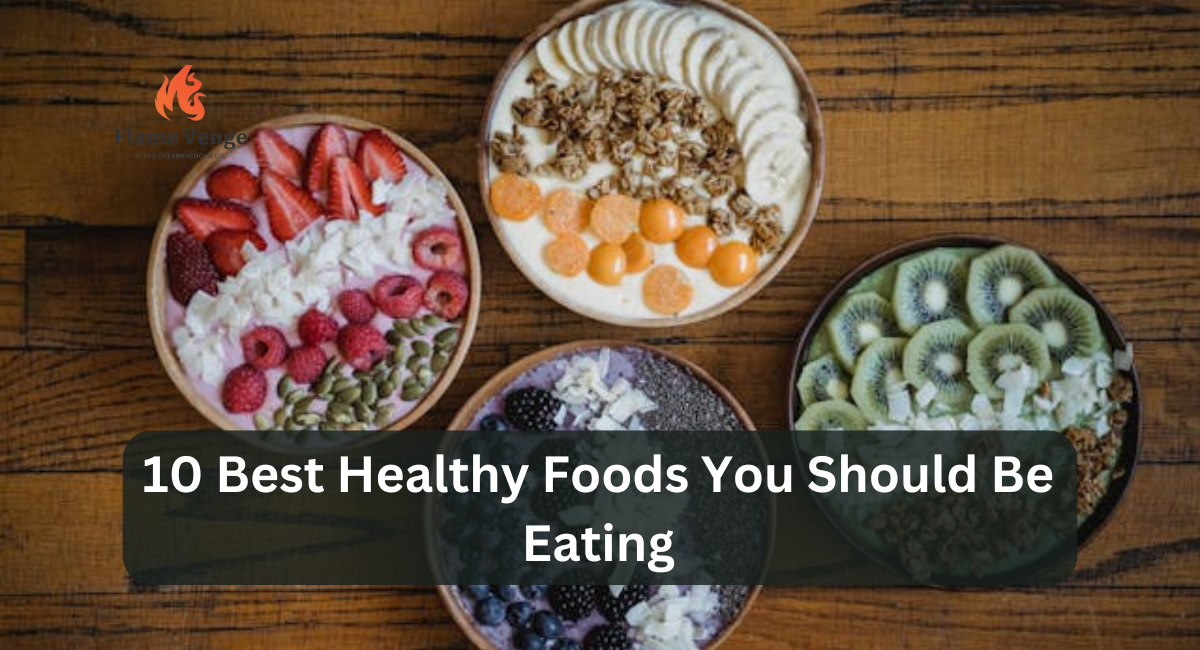Eating healthy foods is important for staying healthy. Including the right foods in your meals can give you more energy, help you manage your weight & lower your chances of getting sick. This guide highlights ten of the healthiest foods you should eat, offering delicious and versatile ways to nourish your body daily.
1. Leafy Greens
Green verdant vegetables like spinach, kale and Swiss chard are extremely smart for you. They have lots of vitamins, minerals & fiber. They help keep your bones and blood healthy because they have a lot of vitamin K. They also have antioxidants that protect your cells and can help you stay healthy.
How to Incorporate:
- Salads: For a nutrient-dense meal, mix a variety of leafy greens with other vegetables, nuts, seeds, and a lean protein source.
- Smoothies: Blend spinach or kale with fruits and a protein source like Greek yogurt for a refreshing, healthy smoothie.
- Stir-fries: Sauté Swiss chard or collard greens with garlic, olive oil, and a lean protein like chicken or tofu.
2. Berries
Berries such as blueberries, strawberries & raspberries are high in fiber, vitamin C, and antioxidants like anthocyanins, which give them their vibrant colors. These antioxidants help fight damage from oxidation and swelling, supporting heart health and lowering the chance of some cancers.
How to Incorporate:
- Breakfast: Add berries to your morning oatmeal, yogurt, or whole-grain cereal.
- Snacks: Enjoy a handful of berries on their own or paired with a handful of nuts for a balanced snack.
- Desserts: Use berries rather than sugar in pastries or blend them into a cool sorbet.
3. Nuts and Seeds
Nuts & seeds like almonds, walnuts, chia seeds & flaxseeds are really good for you. They have healthy fats, protein, fiber, vitamins, and minerals. They also have omega-3 fatty acids, which are important for your brain and reducing inflammation.
How to Incorporate:
- Snacks: Enjoy a small handful of nuts and seeds, or add them to your yogurt or salads for extra crunch.
- Smoothies: Blend chia seeds or flaxseeds into your smoothies for added fiber and omega-3s.
- Baking: Use ground nuts and seeds as a base for homemade energy bars or incorporate them into baked goods for a nutritional boost.
4. Whole Grains
Whole grains like quinoa, brown rice, oats, and barley are rich in fiber, B vitamins, and essential minerals like magnesium and iron. Unlike refined grains, whole grains retain all parts of the grain kernel, making them more nutritious and beneficial for digestive health, weight management, and reducing the risk of heart disease.
How to Incorporate:
- Breakfast: Oatmeal with fruits, nuts, and seeds on top is a great way to start your day.
- Side Dishes: Serve quinoa, brown rice, or barley with lean proteins and vegetables as a side dish.
- Salads: Use whole grains as a base for salads, adding vegetables, lean proteins, and a healthy dressing.
5. Legumes
Legumes, including beans, lentils, chickpeas, and peas, are excellent plant-based protein, fiber, vitamins, and minerals sources. They don’t have much fat and can help control blood sugar levels, so they are useful for individuals with diabetes or attempting to control their weight.
How to Incorporate:
- Soups and Stews: Add lentils, beans, or chickpeas to soups and stews for a hearty, protein-rich meal.
- Salads: Toss cooked legumes with vegetables and a light vinaigrette for a satisfying salad.
- Hummus: Blend chickpeas with tahini, olive oil, lemon juice, and garlic to make a healthy, homemade hummus.
6. Fatty Fish
Oily fish like salmon, mackerel, and sardines are some of the top foods for omega-3 fats, which are really important for your heart and brain. They are also rich in high-quality protein, vitamin D, and selenium, a mineral that supports immune function.
How to Incorporate:
- Grilled or Baked: Grill or bake fatty fish with herbs and lemon for a simple yet flavorful meal.
- Salads: Add flaked salmon or sardines to salads to boost protein and healthy fats.
- Tacos: Use cooked fish as a filling for tacos, topped with fresh tomato sauce and avocado.
7. Cruciferous Vegetables
Broccoli, cauliflower, Brussels sprouts, and cabbage are good for you because they have fiber, vitamin C and K, and special chemicals that can help prevent some types of cancer. These vegetables also support liver detoxification and promote digestive health.
How to Incorporate:
- Roasting: Roast cruciferous vegetables with olive oil and herbs for a crispy, flavorful side dish.
- Stir-fries: Include broccoli or cauliflower with lean proteins and other vegetables in stir-fries.
- Soups: Puree cooked cauliflower or broccoli into soups for a creamy texture without added cream.
8. Greek Yogurt
Greek yogurt is a healthy food that helps your gut. It has protein, calcium, and B12 vitamins. The probiotics in Greek yogurt keep your gut bacteria balanced, which is good for digestion, immune system, and mental health.
How to Incorporate:
- Breakfast: Enjoy Greek yogurt with fruit, nuts, and honey.
- Snacks: Use Greek yogurt as a base for healthy dips, or enjoy it with a sprinkle of cinnamon.
- Smoothies: Blend Greek yogurt into smoothies for added creaminess and protein.
9. Avocados
Avocados have good fats that are good for your heart and brain. They also have fiber, vitamins & minerals like potassium, which can help control blood pressure. Avocados can also help lower bad cholesterol.
How to Incorporate:
- Toast: Spread mashed avocado on whole-grain toast and top with a poached egg or tomatoes.
- Salads: Add sliced avocado to salads for a creamy texture & a boost of healthy fats.
- Smoothies: Blend avocado into smoothies for a rich, creamy consistency and added nutrients.
10. Sweet Potatoes
Sweet potatoes are a nutrient-dense carbohydrate source, high in fiber, vitamins A and C, and antioxidants like beta-carotene. They are better for keeping blood sugar steady because they have a lower glycemic index than regular potatoes.
How to Incorporate:
- Baked: Cook sweet potatoes in the oven and add cinnamon or Greek yogurt on top before serving.
- Mash: Mash cooked sweet potatoes with olive oil or butter for a healthy side dish.
- Fries: Cut sweet potatoes into wedge shapes and bake them instead of frying for a healthier option than regular fries.
Conclusion
Adding these ten healthy foods to your diet can give you many different nutrients that help your body stay healthy. They can help your heart, digestion, and weight. These foods can be used in many different meals and are easy to include in your diet. By making small changes and eating more of these superfoods, you can improve your health and feel better.
These are the healthiest vegetables you need to start eating now

